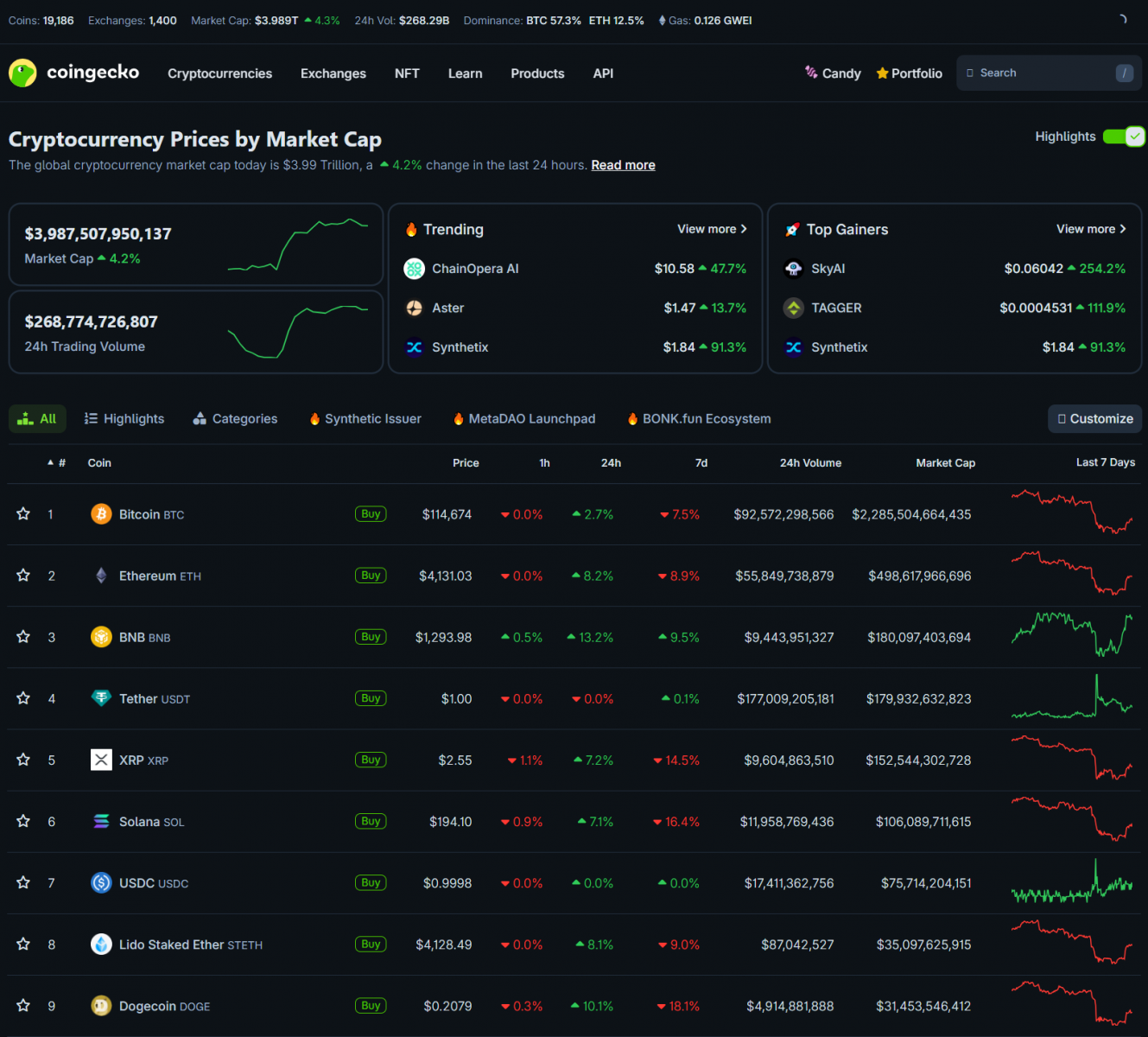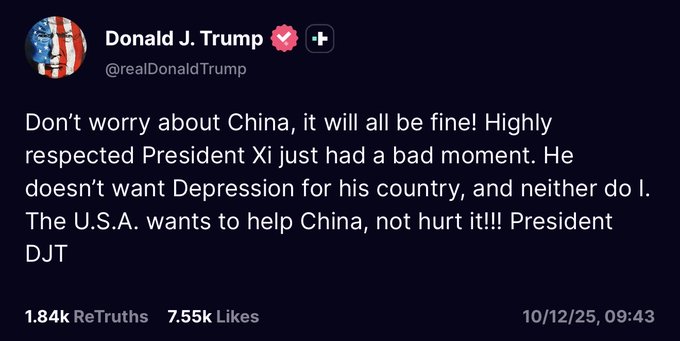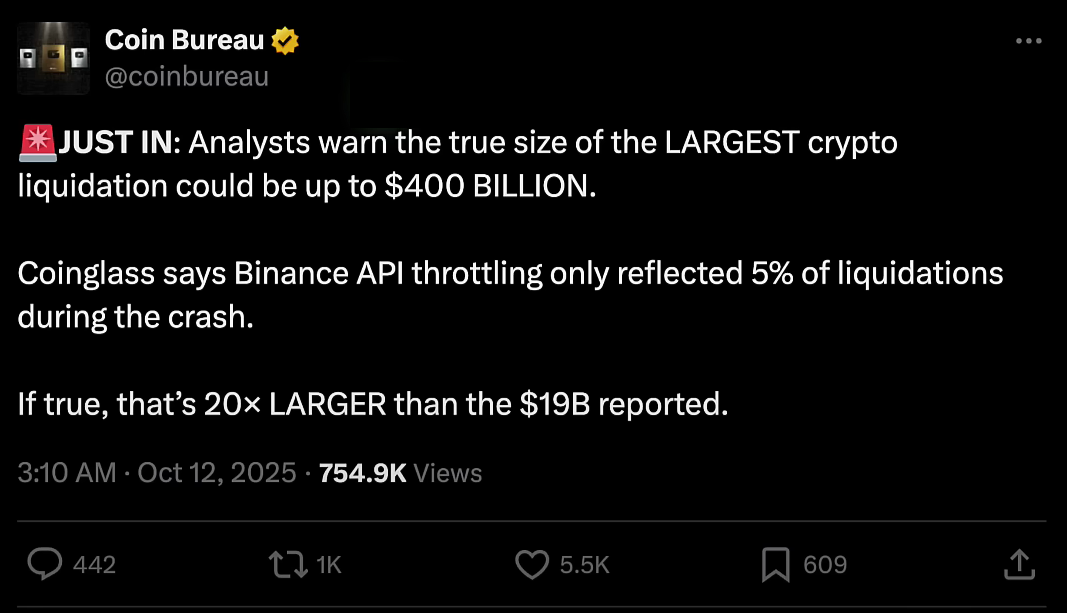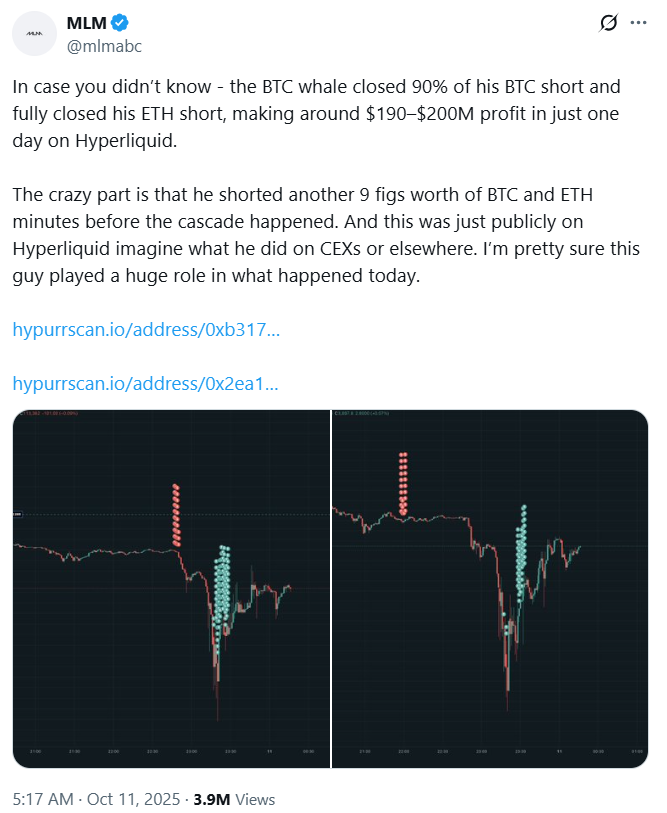The market has stabilized and calmed down after President Trump announced the possibility of opening negotiations with China. Stocks and crypto saw a slight recovery, but the recent crash still leaves many untold stories.
Market Overview
US stock futures saw a slight recovery on Sunday (October 12th, US) as the market stabilized after President Trump's tariff news. Gold futures continued to hold at a high of $4037 per ounce. Oil remained low at $59.4 per barrel.

Bitcoin recovered to the range of $114,000–$115,000. Major altcoins also rebounded but have not yet returned to their pre-crash levels. The overall crypto market capitalization saw a slight increase to $3.98 trillion.

This week (October 13–17), despite Columbus Day, the US stock market will be open while the bond market is closed. The US government is still in a shutdown, so many crucial economic reports like PPI, construction data, and retail sales may be postponed or not released, even after the government reopens. Additionally, the market will be focused on a series of speeches from Fed officials this week.
Tariffs De-escalate
The most notable development came from China following President Trump's announcement last Friday. Beijing affirmed that the new regulations on rare earth exports are not a ban but a measure to protect national security; companies meeting the necessary conditions are still allowed to export for civilian use. China stated that the impact on global supply chains will be minimal and accused the US of imposing high tariffs based on a "double standard."

China also objected to the US imposing additional port fees on Chinese vessels, calling it a violation of WTO rules and declaring it would retaliate with similar measures against US ships. Amidst concerns about a potential ban on rare earth exports, a sector where China holds over 90% of the global market share, Beijing suggested there was only a "misunderstanding" and called for peaceful dialogue. On the US side, Vice President JD Vance said that if China acts reasonably, President Trump is ready for fair negotiations. Trump later reassured the market that relations with China "will be fine" and emphasized that the US wants to cooperate, not harm China. Overall, trade tensions between the two countries show signs of cooling, helping market sentiment stabilize.
The Magnitude of the Crypto Crash: Over $400 Billion Liquidated?
The crypto market just endured a flash crash that saw Bitcoin drop from $121,000 to $106,000 (a 12% loss) before recovering to around $115,000. Despite the high volatility, Bitcoin has held firmly above the $100,000 mark for 157 consecutive days, indicating that the long-term upward trend is still intact. The total market capitalization has rebounded to approximately $3.9 trillion, a 5.3% increase in a single day, with BTC up 3.5%, ETH up 10.7%, and BNB up 13.5%. BNB even nearly regained its previous peak of $1,321, demonstrating the strongest rebound among blue-chip crypto assets.

However, the sharp dip on Friday caused a massive liquidation wave, estimated to be up to $400 billion, vastly exceeding the officially reported figure of ~$19 billion. Many major altcoins like ADA, LINK, SOL, ATOM, and others fell by 70%–90% in minutes due to thin liquidity before quickly bouncing back. This event clearly demonstrates that the concept of "blue-chip crypto" is premature to apply, as even major tokens are prone to steep crashes during periods of panic.
From this shock, it can be concluded that the crypto market is not yet stable enough for the application of traditional financial strategies like "buy, borrow, and die" (buying, borrowing against the asset, and holding indefinitely). Using crypto as collateral still carries an extremely high liquidation risk due to volatility and limited liquidity. The recent flash crash clearly reflected this characteristic: weak capital flow, low liquidity, and sudden selling pressure can cause prices to plummet much faster than in traditional financial markets.
The Stories Behind the Crash
Following the sharp decline, many tragic stories circulated within the crypto community, reflecting the severe consequences of using leverage. An investor on Reddit shared that his entire six years of savings and DCA strategy were wiped out overnight due to leverage. This individual, who had once advised others against speculation, turned to futures trading out of rising costs and a desire to catch up, and ultimately lost everything at age 36. Another, more tragic case involved a 32-year-old fund manager who held $65 million in crypto assets and took his own life in his car after the price collapse, highlighting the mental pressure of managing other people's money.

The market has partially recovered, but resentment and suspicion are widespread. Many investors believe that the crash was not solely due to the news of Trump's 100% tariff threat on China but originated from the crypto market's inherent structural weakness, particularly poor liquidity and high leverage. Data suggests that selling pressure emerged before the news was officially announced, indicating the possibility that a group of "insiders" may have had prior knowledge. When the price fell sharply, a cascade of long liquidations was triggered, and the Binance exchange experienced lag, preventing investors from buying in, which accelerated the pace of the collapse.
Furthermore, there are signs that the sharp price drop in the crypto market did not only stem from President Trump's tariff announcement but may have been predicted or "known in advance" by certain large investors (whales). Bitcoin showed signs of decline 1–2 days before the official news release, indicating that selling pressure had emerged earlier. Market data revealed several massive short orders, including one trader who opened a short position worth $160 million. Notably, this individual was already a large Bitcoin holder and immediately opened a short position (betting the price would fall), suggesting the possibility of prior knowledge of the volatility or a self-hedging strategy against the news.
Crypto.com's CEO has called for an investigation into the cause, similar to when Robinhood was questioned by the US Congress after the GameStop event. Binance subsequently announced it had compensated affected users with $283 million. This incident also revealed the interdependence between smaller and larger exchanges: when a large exchange falters, the entire system can suffer a chain reaction failure. Overall, the recent crash was not just a market accident but a necessary wake-up call about the structural risks in crypto: high leverage, thin liquidity, system dependence, and lack of investment discipline—all of which can cause investors to lose everything in minutes.
Other Key Crypto & Political Updates
According to sources from Fox Business, President Trump may be considering a pardon for CZ (Changpeng Zhao), the founder of the Binance exchange. Many are surprised because CZ has completed his 4-month prison sentence, but the issue is not imprisonment but the legal restrictions still in effect after the plea deal. Under the agreement, CZ is currently prohibited from holding a leadership role at Binance. A pardon, if granted, would remove these limitations, allowing him to return to a leadership position at the exchange.
Michael Saylor once again posted a Bitcoin chart, writing: "Never stop believing in Bitcoin."
Tom Lee's Bitmine company purchased 128,718 ETH (worth approximately $480 million) across six new wallets.
Mike Novogratz's Galaxy Digital is raising $460 million to convert its Bitcoin mining facility in Texas into an AI data center with 3.5 GW capacity, with 800 MW allocated to CoreWeave. The project is projected to generate about $1 billion in annual revenue starting in 2026, marking a strategic pivot for crypto companies towards AI infrastructure to diversify revenue streams.
Sources
- CoinGlass (Liquidation Data)
- Truth Social (President Donald Trump)
- Fox Business
- The New York Times
- Cointelegraph
- Binance Official Statements
- Crypto.com CEO Public Statement
- Mike Novogratz (Galaxy Digital)
Disclaimer
This article is for informational purposes only and should not be considered financial advice. Please do your own research before making investment decisions.


.png)





